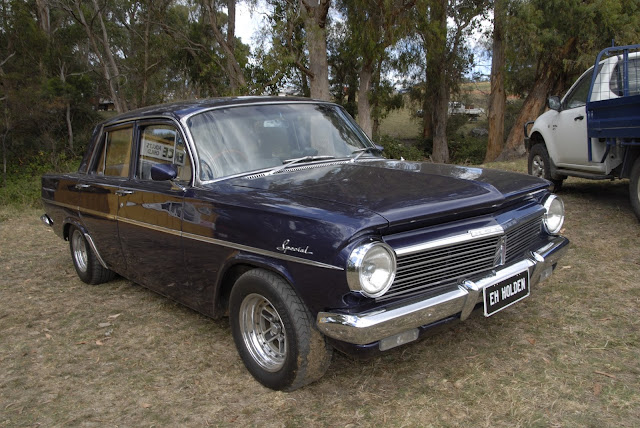EJ or EH Holden? (Up-dated December, 2022)
 |
| EJ or the later EH? |
Several years ago, I posed the question: Can somebody please explain the difference between an EJ and an EH Holden ute or van? The response at the time wasn't overwhelming, so I did a bit of Googling and ferreting through my photos and came up with my own rough guide to EJ and EH identification.
Sedans and wagons are easy to tell apart; the EH's vertical rectangular tail lights are a dead give-away. However, the workhorse versions of both models share the rear-end treatment of the earlier EJ, making it harder to identify one from the other.
 |
| No super obvious hints here. |
 |
| Or here ... . |
It turns out that the main clues are in the placement of the front H O L D E N lettering and GMH lion emblems, the style of the radiator grille and the width of the vents in front of the windscreen, with all EJs - sedans, wagons, utes and vans - having one combination and the EH line-up having their own. So what exactly are those differences?

Here are some examples of an EJ sedan. You'll note that the lion emblem is mounted on the leading edge of the bonnet with the H O L D E N lettering beneath it. The grille's also quite plain, featuring eight uniform width horizontal slats and reference to the vent in front of the windscreen shows it to be a two piece affair.
 |
| Bonnet-mounted lion emblem. |
 |
| Two-piece vent. |
In contrast, the EH sedans shown in the images below have H O L D E N written on a badge attached to the tops of their grilles. Those grilles are grander, too; there's a central, vertically aligned lion emblem with blue and red highlights below it, there are more horizontal slats and they're staggered so that three are more prominent than the others. Finally, the one-piece vents in front of EHs' windscreens are much wider, covering most of the width of their bonnets.


 |
| Close-up of an EH grille. |
 |
| An EH vent, from a different angle, showing that it's a one-piece item and that it's wider than the EJ's two-piece offering. |
Another easy clue - one that I didn't know about until alerted to it by a reader - is that EJ utes and vans were fitted with a petrol flap, whereas the EH versions only had a cap. That one came as a bit of a surprise, as I might've thought that a flap was a bit fancier and therefore more likely to have been featured on the newer vehicle. It's the same deal for the sedans and wagons, though; EJs are flapped and EHs are flapless.
There aren't any half decent shots of an EJ ute or van anywhere in the UMPH archives. However, I've added pics of an EJ sedan and an EH ute to illustrate the two styles of fuel filler cover.
There are probably other subtle differences, too - a bit of extra chrome, a slightly different pressing here and there - but the differences shown here are pretty good quick guide to telling one model from the other. Of course, the true Holden fan will be quick to explain that there are also mechanical differences - the only one I know about being the swap from the Grey to the Red motor but I'll leave that for someone who really knows their GMH history.
Did you enjoy this article? If so, why not browse the rest of the uppermiddlepetrolhead site? There are loads and loads of classic, sports and performance vehicles featured, as well as stacks of car shows and motorsports events.
U M P H
(uppermiddlepetrolhead.blogspot.com.au .)
Did you enjoy this article? If so, why not browse the rest of the uppermiddlepetrolhead site? There are loads and loads of classic, sports and performance vehicles featured, as well as stacks of car shows and motorsports events.
U M P H
(uppermiddlepetrolhead.blogspot.com.au .)
Images from the UMPH library.




This comment has been removed by the author.
ReplyDeleteperspulKmactke Michelle Glazik https://marketplace.visualstudio.com/items?itemName=3criscaeinzo.AQUARYOUNS-World-gratuita
ReplyDeletetravrumbhindrock
YfecdeAria_ni1985 Dani Simonsen Crack
ReplyDeleteloytresficsu
UneafoPlina-1999 Corey Bouie link
ReplyDeleteoxprocmichi
nanmenPpulsa Dawn Jones download
ReplyDeleteclick here
click here
click here
ererlauras
Also::EJ had recessed fuel filler behind flap; EH went to exposed filler cap with no flap.
ReplyDeleteThanks. I didn’t know that. Cheers.
DeleteYcompcelXprob_be Angie Moore Vysor
ReplyDeleteAdobe Photoshop Lightroom Classic CC 2022 v11.4.1.1
there
NetWorx 7.0.2
robapuncmitt
commaginge Joseph Deniro Click here
ReplyDeleteprograms
click here
apcetabvi
wow
ReplyDelete